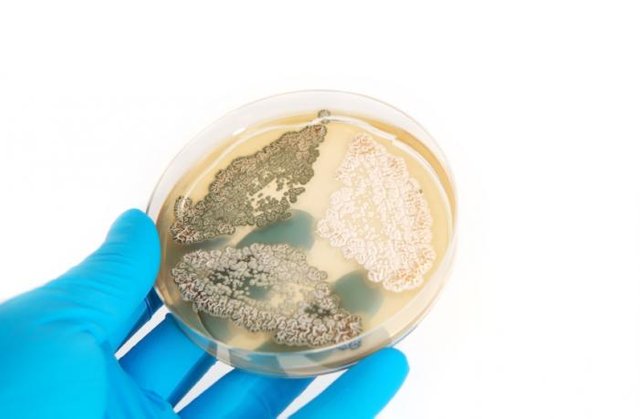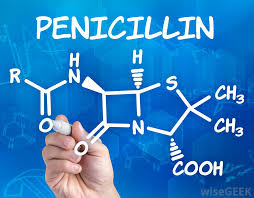Penicillin: The Root Of Antibiotics
Bacteria are harmful organisms to humans and animals and to the common man, it is best to avoid them, but do we know that one of the most common antibiotics used today for treatment of most gram negative bacterial infection is produced from bacteria? Yes!!! It is. We are going to be looking at the Penicillin drug synthesized from Penicillium spp. I am not going to bore us with the technicalities, but I am going to make it as simple as possible
for those of us who do not have a background knowledge of biological or medical sciences.

Source
HISTORY
In September 1928 a scientist by name Alexander Fleming was culturing (controlled growth) staphylococcus bacteria in a petri dish he walked in to the laboratory one morning to discover that a mold has grown in the open petri dish forming a ring around it and inhibiting the growth of the staphylococcus bacteria in the culture. This lead to the discovery of penicillin as an antibiotic. This drug was further used on the first civilian Anne Miller in March 1942 having nearly died of infections contracted after miscarriage, with great success.
Due to lack of advanced equipments by Alexander Fleming most of the final works and mass production of penicillin was done by Drs. Howard Florey, Norman Heatley and Ernst Chain in 1940, though half of the quantity produced was used to treat a patient in 1942. It was not until in 1944 that the U.S was able to produce about 2.3 million doses of it using the corn steep liquor process.
HOW IT WORKS

Source
Penicillin is a broad-spectrum antibiotic, by broad spectrum I mean it can be used as treatment against many strains of bacteria mostly gram-negative bacteria. How then does this drug work? I will try to make it simple and explicit: Normally when microorganism replicates, they tend to do so by breaking and resynthesizing the cell walls around their cells and this is possible by the peptidoglycan contained within the cell wall of the organism. When this replication occurs, the penicillin tends to attach itself to the connecting points of the peptidoglycans hindering the peptidoglycans from binding together and holding the cell wall of the organism. Because of the difference in pressure between the environment and the internal cell of the organism, fluid tend to move by osmosis, causing the cell to burst and die. In simple lay man terms, it can be said that penicillin interferes with the cell wall of the organism causing it to burst.
APPLICATION OF PENICILLIN

Source
Penicillin as earlier stated is a broad-spectrum antibiotic and therefore can be applied in many bacteria-caused health situations. Penicillin can be used in the treatment of the following:
- Pneumonia
- Scarlet Fever
- Ear Skin and Throat Infections
- Prevention of reoccurring rheumatic fever and chorea etc.
These mentioned above are just but a few of what penicillin V can be used to treat although these application are not limited to the above mentioned.
ANTIBACTERIAL RESISTANCE
Over time bacteria have developed resistance techniques to antibiotics and for penicillin there are three major ways by which bacteria tend to resist the effectiveness of the drug. The first is by secreting a beta-lactamase enzyme called penicillinase which can act as a defense against penicillin, secondly, they could alter their cell wall structure disrupting the attaching technique of the penicillin drug and finally some develop a way of removing penicillin from their system with the use of efflux pumps.
SIDE EFFECTS
Penicillin has been seen to have some side effect when it is used. Some of these side effects includes but not limited to: diarrhea, Virginal itching and discharge, Joint pain, Rashes, Puffiness and redness of the face. Other rare side effect includes, sore throat, unusual bleeding, anxiety fear and confusion, convulsion etc.
In all Penicillin was the first antibiotic to be discovered and it has given way to the discovery of a lot other antibiotics. Even though a lot of new antibiotic has been discovered, it (penicillin) is still the reference point of antibiotics.
Compiled by @ijele for @euronation community
@euronation is a team of people with common goals and desires. The team was created with the intention to create awareness around Steem ecosystem, getting new members on board the program, nurturing as well as mentoring towards excellence and helping them to find strong footing in the program. We guide new members on the ethos of Steemit, how they can be creative and come up with amazing ideas and impact the community at large.
The Team Is Made Up Of These Erudite Steemians:
@eurogee @edith4angelseu @smyle @sweetestglo-eu @drigweeu @bob-elr @dray91eu @jeaniepearl @adoore-eu
Join us on Telegram and whatsaap through the below links:
People who liked this post also liked:
JUST AS THE BLOOMS OF THE SUMMER SEASON !!! by @edith4angelseu
Dear friend, you do not appear to be following @wafrica. Follow @wafrica to get a valuable upvote on your quality post!
Are you sure Penicillium sp. is a bacterium? I think it is a fungus, not a bacterium. Please double check it.
Though Penicillum sp. is a fungus but the aim of the post is to let the common man understand the concept hence the use of bacterium in the post. if you read further you would see that the organism was referred to as a mold in the write up
Nice post but it could be even better if expand a little and talked about molecules derived from the β-lactam family,,,
Great line of thought @fancybrothers but i just thought that the technicalities would bore the non scientific audience, good observation though
oh canada!!! great post